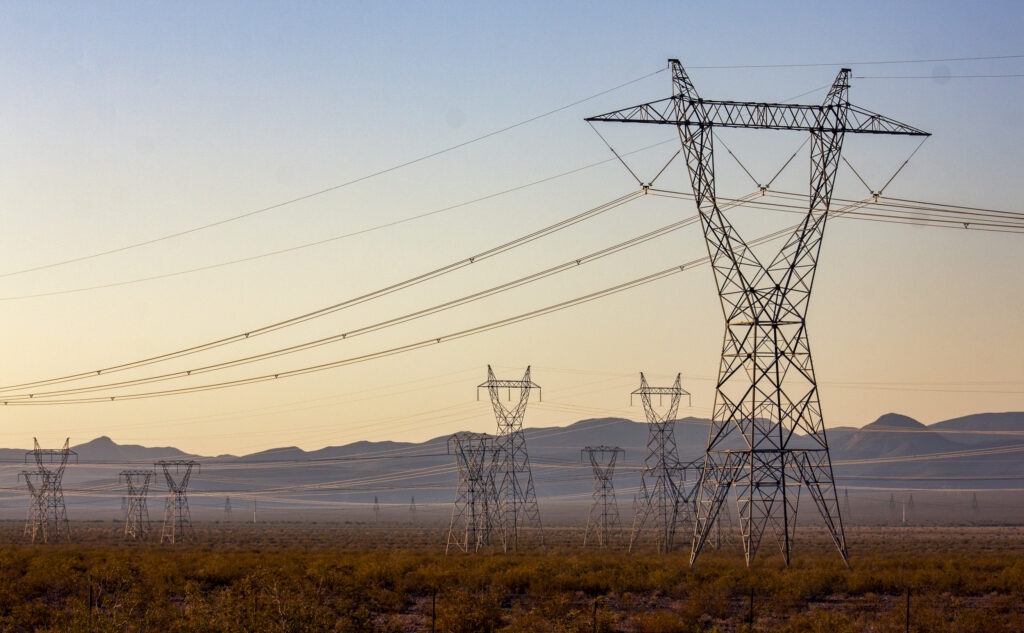
In late May, as the outside temperature approached 100 degrees, Arizona’s top water policy officials gathered in an air-conditioned Phoenix conference room. Their purpose that day was to decide whether the state should extend a longstanding drought emergency declaration. The standard indicators – minimal precipitation, low reservoirs, the second-hottest 12-month period on record – were not encouraging.
Halfway through the 90-minute meeting, gallows humor lightened the mood.
Ed Gerak, executive director of the Irrigation and Electrical Districts Association of Arizona, which represents power providers that receive federal hydropower from Colorado River dams, had the mic. Gerak shuffled through a matter-of-fact slide deck that explained how hydropower output from those dams, particularly the two largest, Hoover and Glen Canyon, has been diminished by shrinking reservoirs.
In the middle of the presentation, Tom Buschatzke, director of the state water agency, noticed a misspelling on the screen. He asked Gerak to scroll back to the previous slide.
“Is that Freudian?” Buschatzke asked. “Or did you put ‘Hoover Doom’ on purpose?”
For the millions of water and power customers in the Colorado River, it certainly feels that way. The typo, which received a knowing laugh from those in the room, cuts close to the truth.
The mood in the Colorado River basin is dreadful. River forecasts consistently overestimated runoff this year. Reservoirs are on a knife’s edge. The basin, on the whole, is drying. That’s frightful for the 40 million people and 5 million acres that the river supplies with water. But it’s also worrisome for electricity generation. Lakes Mead and Powell, the basin’s two largest reservoirs, are approaching critical levels in which hydropower from their dams (Hoover and Glen Canyon, respectively) would be severely curtailed or altogether cease.
Losing a power source at a time of life-threatening heat, rapidly rising electricity demand due to data centers and population growth, and a changing energy mix would be a blow to the region, though hydropower is a small portion of overall regional electricity supply. The impact of a hydropower cut would be unevenly distributed.
The mood in the Colorado River basin is dreadful. River forecasts consistently overestimated runoff this year. Reservoirs are on a knife’s edge. The basin, on the whole, is drying.
Small utilities have the most to lose. They operate with tiny customer bases,rely primarily on the dams and are at the mercy of market rates to cover hydropower shortfalls..
“We’re absolutely concerned about Mead dropping more,” said Dane Bradfield, general manager of Lincoln County Power District, in eastern Nevada, one of those at-risk small utilities. Hoover provides about 70% of its power, down from 100% two decades ago. “It’s on our minds every day.”
At the other end of the spectrum is the Gila River Indian Community Utility Authority, which serves the Arizona tribe whose lands surround the Gila River. Federal hydropower is only about 12% of its supply and its solar generating assets are growing rapidly.
“We’re not too put off,” said Kenneth Stock, the utility authority’s general manager, about less electricity from Hoover and Glen Canyon.
Acting like responsible asset managers who value diverse portfolios both Lincoln County Power and Gila River Indian Community, not to mention other utilities in the basin, are changing with the times. As the power of flowing water becomes less reliable, they are turning to an energy resource that is almost always on in the Southwest during the day: the sun.
The Rise and Fall of an American Icon
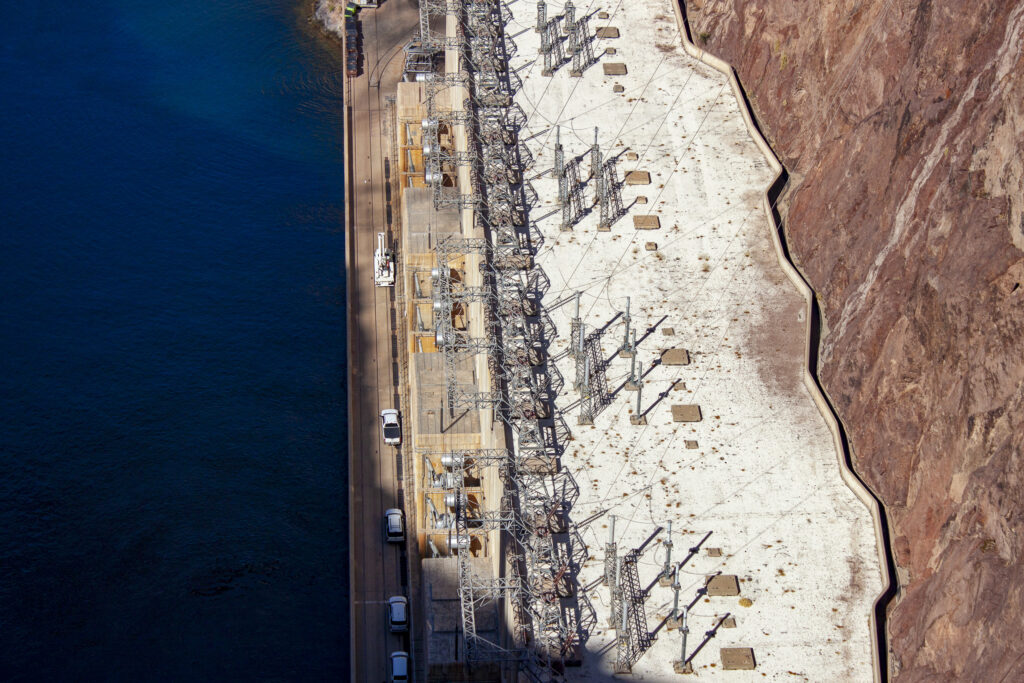
Opened in 1936, in the midst of a national economic calamity, Hoover Dam was an expression of American optimism, worker desperation, and engineering prowess. Everything about its construction was monumental, from the 135 vertical feet of river bed that was excavated for the dam’s foundation to the creation of a town and rail lines that housed workers and ferried supplies to the remote and inhospitable Black Canyon work site, some 25 miles southeast of Las Vegas.
Walking inside Hoover’s labyrinth of tunnels, visitors today feel the dam vibrate with the impounded force of the Colorado River moving through its turbines.
Ever since these turbines started spinning, Hoover Dam electricity has flowed to irrigation districts, Native American tribes, cities, and industries. One of those original recipients is Lincoln County Power District. The tiny utility serves about 5,000 people across more than 10,000 square miles of rural eastern Nevada.
Until 2005, when the Colorado River reservoirs were in the early days of their 25-year plunge, Hoover Dam was the only power source Lincoln County needed. The dam provided all the district’s electricity.
Lincoln County is getting less hydropower because the dams have less to give. Since the turn of this century, Hoover’s electrical output has dropped in tandem with Lake Mead’s decline. Annual generation is down by about half since 2000, the last year the reservoir was full.
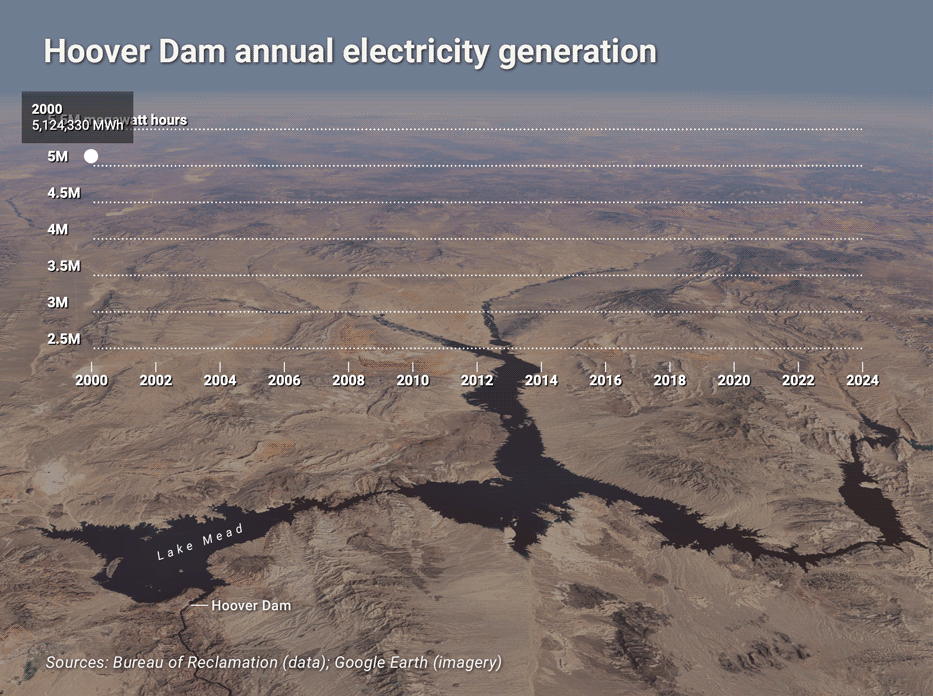
Since the turn of this century, Hoover’s electrical output has dropped in tandem with Lake Mead’s decline. Annual generation is down by about half since 2000, the last year the reservoir was full.
More reductions might be in store. According to the Bureau of Reclamation, the federal agency that manages the basin’s large dams, if Lake Mead falls another 23 feet – to elevation 1,035 feet – Hoover Dam’s capacity to generate electricity would be slashed by 70% from its current level.
The huge drop in hydropower output is due to physics. A higher column of water behind a dam provides more pressure to spin the electricity-generating turbines. Less water, less pressure, less hydropower.
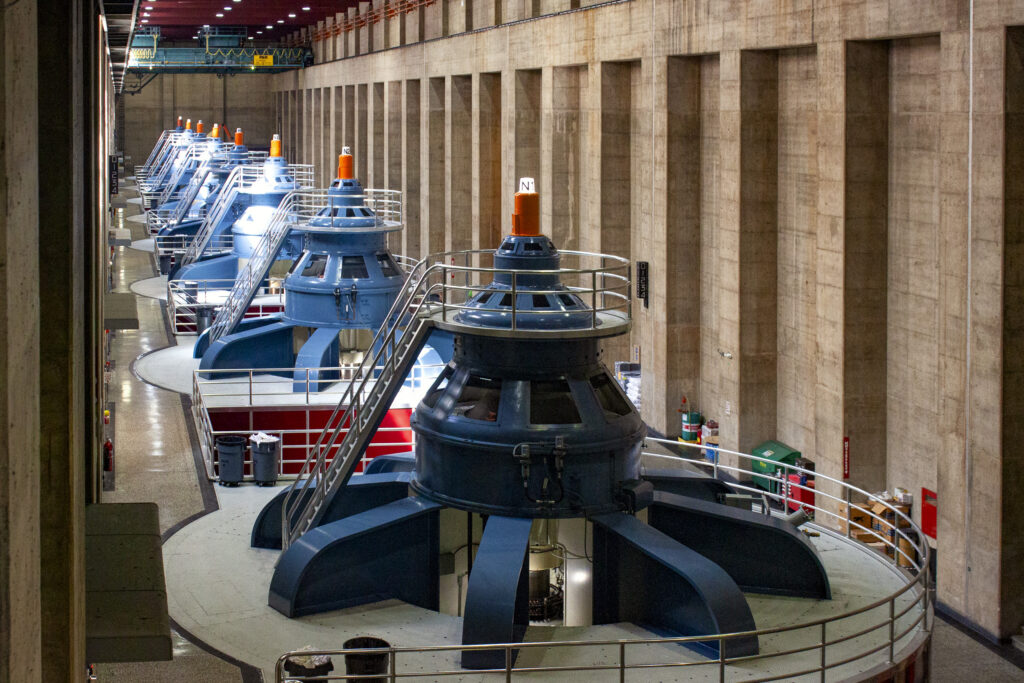
Twelve of Hoover’s 17 turbines are older units that were not designed to operate at low water levels. They could be damaged in a process called cavitation.
Twelve of Hoover’s 17 turbines are older units that were not designed to operate at low water levels. They could be damaged in a process called cavitation. This happens when miniscule air bubbles form due to water pressure changes. When the bubbles rupture, they gouge the turbine blades. Reclamation estimated this summer that replacing these older turbines with low-head units that are not prone to cavitation would cost $156 million.
Power customers, whose rates pay for dam operations and maintenance, hope Congress will come to their aid. One option would be an appropriation for the turbine upgrades. Another, unlocking some $50 million in funds set aside for pension benefits for federal employees. Power customers argue that the pensions are funded through other means and that Reclamation needs congressional approval if it were to spend the money on new turbines.
A severe curtailment of Hoover power is not implausible. Every month, Reclamation updates its projection of reservoir levels over the next two years. The June update shows a 10% chance that Lake Mead dips below 1,035 feet in spring 2027.
Glen Canyon Dam, the other big hydropower asset in the basin, is also in trouble. According to Reclamation, hydropower there will cease when Lake Powell falls below elevation 3,490 feet. The latest Reclamation projections indicate a 10% chance of that happening by September 2026. The agency is considering its options for the low-water scenario, but not publicly saying much more.
“Reclamation is in the early stages of developing and comparing alternatives for producing power below 3,490 feet and providing additional water delivery flexibilities,” Jennifer Erickson, a Reclamation spokesperson, wrote in an email. “It would be premature at this time to speculate on those results.”
A Bright Spot
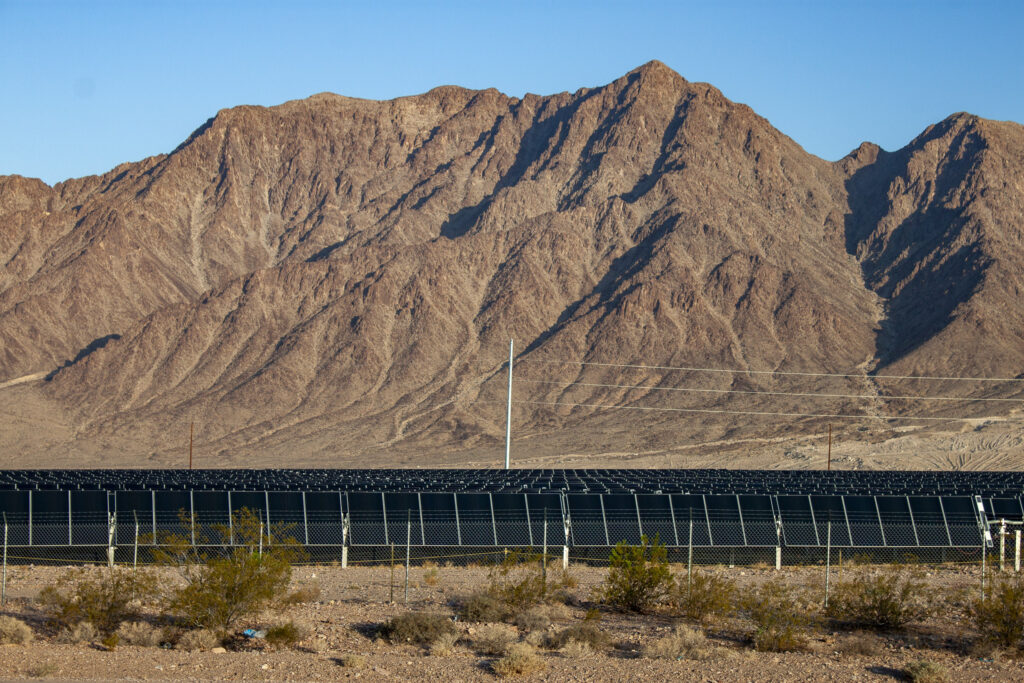
Solar power is growing as a share of utility electricity regionally and nationally, even as solar faces stiffening headwinds from the Trump administration
Amid the gloomy hydropower projections, one power source in the basin is producing real and measurable progress. Solar power is growing as a share of utility electricity regionally and nationally, even as solar faces stiffening headwinds from the Trump administration. The White House has pulled funding for renewables and cancelled projects.
Lincoln County Power District, attempting to diversify from hydropower, is one of several electric power cooperatives that will benefit from Apache Solar II, a solar and battery storage project of Arizona Electric Power Cooperative that is expected to go online in December. Lincoln County will receive 5 megawatts.
The power district is also building its own 2-megawatt solar project thanks to a congressional earmark in the 2023 budget bill. Dane Bradfield, the district’s general manager, expects construction to begin next spring and electricity to begin flowing in the third quarter of 2027.
Solar is helpful for the power district because it will reduce its purchased power costs, which tend to be more expensive. When hydropower shortfalls occur, the district has to buy electricity on the market. It does so a year in advance through something called a power hedge. Market purchases also take place during the year if hydropower is less than expected or demand is higher than forecast. If electricity demand is high, market prices can be expensive. The district instituted a surcharge on customers starting in 2022 that provides reserve funds for when purchased power costs exceed the district’s forecast.
To the south, Gila River Indian Community Utility Authority is in an even stronger solar-power position, one that developed rapidly.
In the last three years, solar in Gila River went from almost zero – “extremely minimal rooftop solar,” said Kenneth Stock, the general manager – to 30% of the utility’s supply.
Gila River is not stopping there. The utility just broke ground on a nearly 21-megawatt solar project that should be completed in 18 to 24 months, Stock said. That’s in addition to smaller developments such as installing a half-mile of solar panels atop the Casa Blanca Canal. The 1.3-megawatt project was funded by the Biden administration’s infrastructure bill.
Even Boulder City, the community that was founded to house workers who built Hoover Dam, is moving in that direction.
Federal hydropower from the Colorado River provides about half of Boulder City’s electricity, according to Joe Stubitz, the city utilities director. But the city picked up 5 megawatts of solar and battery storage in 2022 through a power purchase agreement, and it wants more.
“What we’re doing now is we’re looking for other options, preferably renewables, to supplement that loss of capacity at Hoover,” Stubitz said.
Peak Value
Though solar is blunting the pain from Hoover’s power decline for individual utilities, less hydropower has broader ripple effects.
Hydropower’s value is measured not just in megawatts. It’s measured in its ability to rapidly turn on and off to respond to changes in electricity demand. This ramping power is important for today’s electrical grid in helping weave increasing amounts of solar and wind into the power mix.
In the early evening, power demand spikes as people return home from work and turn on appliances. At the same time, the sun is setting and solar generation is dropping. Utility-scale batteries typically have only four hours of storage. In these situations, hydropower can be flipped on, ready to generate power in minutes.
“We really count on [hydropower] to help us meet our peak demand,” said Grant Smedley, director of resource planning, acquisition, and development at Salt River Project during a meeting in August of the Glen Canyon Adaptive Management Program work group.
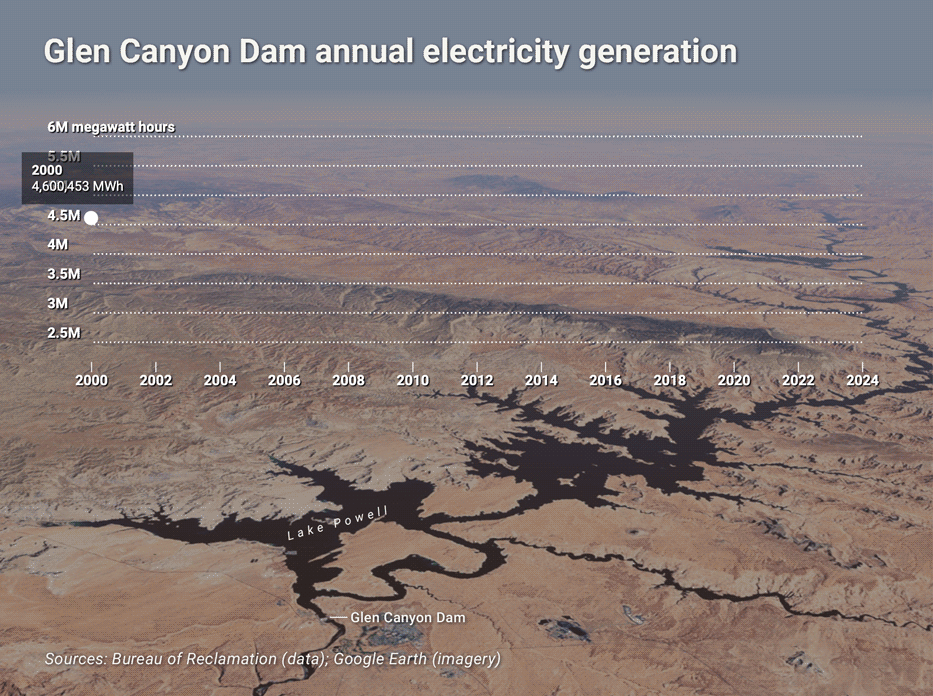
What happens if Glen Canyon stops producing hydropower? Utilities will need to rely on a more diverse power mix.
Salt River Project provides water and energy to 2 million people in central Arizona. Solar, wind, and batteries today are less than a quarter of its power portfolio. By 2035, that number is expected to reach three quarters, Smedley said.
What happens if Glen Canyon stops producing hydropower? Utilities will need to rely on a more diverse power mix, including, in some cases, fossil fuel resources, to ensure the reliability of the system.
“I think that’s just a reality that we’re going to have to operate in,” Smedley said. “And so we recognize that we may be in that future for a bit, but to the extent that it’s available, [hydropower] is a very important part of our portfolio.”
This story was produced by Circle of Blue, in partnership with The Water Desk at the University of Colorado Boulder’s Center for Environmental Journalism.
Longform Story CSS Block


